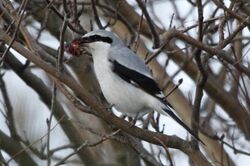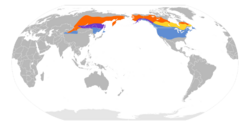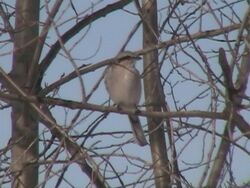Biology:Northern shrike
| Northern shrike | |
|---|---|

| |
| Scientific classification | |
| Domain: | Eukaryota |
| Kingdom: | Animalia |
| Phylum: | Chordata |
| Class: | Aves |
| Order: | Passeriformes |
| Family: | Laniidae |
| Genus: | Lanius |
| Species: | L. borealis
|
| Binomial name | |
| Lanius borealis Vieillot, 1808
| |
| Subspecies | |
|
6 sspp, see text | |

| |
The northern shrike (Lanius borealis) is a large songbird species in the shrike family (Laniidae) native to North America and Siberia. Long considered a subspecies of the great grey shrike, it was classified as a distinct species in 2017. Six subspecies are recognised.
Taxonomy
The northern shrike was formally described by the French ornithologist Louis Pierre Vieillot in 1808 under its present binomial name Lanius borealis.[2][3] In the 19th century, North American ornithologists considered it as a separate species from the great grey shrike, while European authorities held them to be the same species. American ornithologist Alden H. Miller investigated differences between the Siberian and Alaskan populations in 1930 and could find no consistent differences, hence he recommended combining the two into Lanius excubitor.[4]
In North America, this and the related loggerhead shrike are commonly known as butcherbirds for their habit of impaling prey on thorns or spikes.[5] A folk name from Michigan is winter butcherbird.[6] The Vuntut Gwitchin First Nation people of Old Crow, Yukon call it Tzi kwut go katshi lyi.[7] As a passerine, or song bird, it has no talons. It has the hooked beak of a raptor.
A 2010 study of mitochondrial DNA found that the northern shrike was most closely related to the Iberian grey shrike (Lanius meridionalis), the steppe grey shrike (Lanius pallidirostris), and the two formed a clade along with the Chinese grey shrike and loggerhead shrike.[8]
Subspecies
East Eurasian group
- Lanius borealis sibiricus – eastern Siberia to northern Mongolia
- Browner above than excubitor, distinct but delicate banding below. Some white on primary bases only.
- Lanius borealis bianchii – Sakhalin and possibly southern Kuril Islands
- Smaller and paler than sibiricus, banding below pale and indistinct. Some white on primary bases only.
- Lanius borealis mollis – Russian Altai Mountains, north western Mongolia
- Browner than sibiricus above, banding below well-developed. Little white on primary bases.
- Lanius borealis funereus – Tian Shan and western China
- Large; quite dark and brownish, below bluish-grey with almost black banding. Little white on primary bases.
North American group
- Lanius borealis borealis – Hudson Bay region of Ontario and Quebec
- Similar to excubitor, but darker with faint barring below. John James Audubon called this subspecies the great American shrike in his book Birds of America.
- Lanius borealis invictus – northern Alberta west to northern Alaska, perhaps also Chukchi Peninsula region in extreme north east Siberia
- Larger and paler than borealis, paralleling homeyeri compared to excubitor.
Description
The loggerhead shrike can be distinguished from the northern shrike by its smaller size, darker grey plumage and larger black face mask that covers the eye completely. It also has a shorter bill with less prominent hook. Their calls are similar.[9]
Measurements:[10]
- Length: 9.1–9.4 in (23–24 cm)
- Weight: 2.0–2.8 oz (57–79 g)
- Wingspan: 11.8–13.8 in (30–35 cm)
Distribution and habitat
Observations of wintering habitats in Idaho suggest suitable wintering territories are in demand, as northern shrikes that died in a particular area were quickly replaced.[11]
Feeding
Northern shrikes often sit on tall poles and branches surveying for food. They prey on arthropods such as spiders, beetles, bugs, and grasshoppers, and small vertebrates. Prey identified include passerine birds such as horned lark, black-capped chickadee, common starling, brewer's sparrow, white-crowned sparrow, dark-eyed junco, pine siskin, house sparrow, small mammals such as the vagrant shrew, western harvest mouse, deer mouse, long-tailed vole, meadow vole and house mouse, and reptiles such as spiny lizards. They have been observed hunting finches and house sparrows at bird feeders.[5] They are known to lure small birds by initiating their calls.[12]
References
- ↑ BirdLife International (2017). "Lanius borealis". IUCN Red List of Threatened Species 2017: e.T103718956A118775235. doi:10.2305/IUCN.UK.2017-3.RLTS.T103718956A118775235.en. https://www.iucnredlist.org/species/103718956/118775235. Retrieved 19 November 2021.
- ↑ Mayr, Ernst; Greenway, James C. Jr, eds (1960). Check-list of Birds of the World. 9. Cambridge, Massachusetts: Museum of Comparative Zoology. p. 335. https://biodiversitylibrary.org/page/14481030.
- ↑ Vieillot, Louis Pierre (1808) (in French). Histoire naturelle des oiseaux de l'Amérique Septentrionale. 1. Paris: Desray. p. 80, plate 50. https://biodiversitylibrary.org/page/47004229.
- ↑ Miller, Alden H. (1930). "The status of Lanius borealis as a species". Condor 32: 163–64. doi:10.2307/1363449. https://sora.unm.edu/sites/default/files/journals/condor/v032n03/p0163-p0164.pdf.
- ↑ Jump up to: 5.0 5.1 Atkinson, Eric C.; Cade, Tom J. (1993). "Winter foraging and diet composition of Northern Shrikes in Idaho". Condor 95 (3): 528–35. doi:10.2307/1369596. https://sora.unm.edu/sites/default/files/journals/condor/v095n03/p0528-p0535.pdf.
- ↑ McAtee, W. L. (1951). "Bird names connected with weather, seasons, and hours". American Speech 26 (4): 268–278. doi:10.2307/453005.
- ↑ Irving, Laurence (1958). "Naming of birds as part of the intellectual culture of Indians at Old Crow, Yukon Territory". Arctic 11 (2): 117–122. doi:10.14430/arctic3738.
- ↑ Olsson, Urban; Alström, Per; Svensson, Lars; Aliabadian, Mansour; Sundberg, Per (2010). "The Lanius excubitor (Aves, Passeriformes) conundrum—Taxonomic dilemma when molecular and non-molecular data tell different stories". Molecular Phylogenetics and Evolution 55 (2): 347–357. doi:10.1016/j.ympev.2009.11.010. PMID 19925872. http://birdingfrontiers.com/wp-content/uploads/2013/12/The-Lanius-excubitor-Aves-Passeriformes-conundrum.pdf.
- ↑ Dunn, Jon Lloyd; Alderfer, Jonathan K. (2006). National Geographic Field Guide to the Birds of North America. National Geographic Books. p. 312. ISBN 9780792253143. https://books.google.com/books?id=gA-rfkTZi1YC&pg=PA312.
- ↑ "Northern Shrike Identification, All About Birds, Cornell Lab of Ornithology" (in en). https://www.allaboutbirds.org/guide/Northern_Shrike/id.
- ↑ Atkinson, Eric C. (1993). "Winter territories and night roosts of Northern Shrikes in Idaho". Condor 95 (3): 528–35. doi:10.2307/1369595. https://sora.unm.edu/sites/default/files/journals/condor/v095n03/p0515-p0527.pdf.
- ↑ Atkinson, Eric C. (1997). "Singing for Your Supper: Acoustical Luring of Avian Prey by Northern Shrikes". The Condor (Oxford University Press (OUP)) 99 (1): 203–206. doi:10.2307/1370239. ISSN 0010-5422.
External links
- Northern shrike – Lanius borealis – USGS Patuxent Bird Identification InfoCenter
- Northern shrike species account – Cornell Lab of Ornithology
Wikidata ☰ Q31874734 entry
 |



